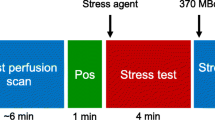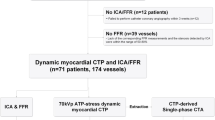Abstract
Background
Previous studies have demonstrated accurate diagnosis of reduced dose myocardial perfusion imaging (MPI) using Cadmium-Zinc-Telluride (CZT) technology. We compared the diagnostic performances of very low stress-dose (<2 mSv) with standard-dose stress-first, quantitative MPI using a CZT camera.
Methods
Patients without known coronary artery– disease who underwent a stress-first Tc-99 m sestamibi CZT-MPI and invasive coronary angiography (ICA), and low-risk patients without ICA were included. A stress-rest standard-dose (10/30 mCi) MPI and a low-dose (5/15 mCi) MPI were compared. Normal limits for quantification were developed from 40 (20 males) low-risk patients, and total perfusion deficit (TPD) was derived.
Results
208 patients who underwent MPI and ICA, and 76 low-risk patients were included. Of these, 128 had a standard-dose MPI and 156 had a low-dose MPI. Stress-doses in low-dose and standard-dose groups were 5.9 ± 1.2 vs 10.2 ± 0.5 mCi (1.7 ± 0.3 vs 3.0 ± 0.1 mSv), respectively, P < 0.001, and stress-rest effective radiation was 6.9 ± 1.1 vs 11.7 ± 0.4 mSv, respectively, P < 0.001. Sensitivity, specificity, and accuracy values in the low-dose and standard-dose groups were 86.1%, 76.6%, and 81.4%; and 90.6%, 78.1%, and 84.4%, respectively, P = ns. Using TPD prone, specificity values were 84.9% and 80.3%, respectively, P = ns.
Conclusion
One-day stress-first MPI with 50% radiation reduction and a very low stress-dose (<2 mSv) using CZT technology and quantitative supine and prone analysis provided a high diagnostic value, similar to standard-dose MPI.





Similar content being viewed by others
References
Cerqueira MD, Allman KC, Ficaro EP, Hansen CL, Nichols KJ, Thompson RC, et al. Recommendations for reducing radiation exposure in myocardial perfusion imaging. J Nucl Cardiol. 2010;17:709-18.
Sharir T, Ben-Haim S, Merzon K, Prochorov V, Dickman D, Ben-Haim S, et al. High-speed myocardial perfusion imaging initial clinical comparison with conventional dual detector anger camera imaging. JACC Cardiovasc Imaging. 2008;1:156-63.
Esteves FP, Raggi P, Folks RD, Keidar Z, Askew JW, Rispler S, et al. Novel solid-state-detector dedicated cardiac camera for fast myocardial perfusion imaging: Multicenter comparison with standard dual detector cameras. J Nucl Cardiol. 2009;16:927-34.
Sharir T, Slomka PJ, Hayes SW, DiCarli MF, Ziffer JA, Martin WH, et al. Multicenter trial of high-speed versus conventional single-photon emission computed tomography imaging: Quantitative results of myocardial perfusion and left ventricular function. J Am Coll Cardiol. 2010;4:1965-74.
Gambhir SS, Berman DS, Ziffer J, Nagler M, Sandler M, Patton J, et al. A novel high-sensitivity rapid-acquisition single-photon cardiac imaging camera. J Nucl Med. 2009;50:635-43.
Slomka PJ, Patton JA, Berman DS, Germano G. Advances in technical aspects of myocardial perfusion SPECT imaging. J Nucl Cardiol. 2009;16:255-76.
Sharir T, Slomka PJ, Berman ds. Solid-State SPECT technology: Fast and furious. J Nucl Cardiol. 2010;17:890-6.
Garcia EV, Faber TL, Esteves FP. Cardiac dedicated ultrafast SPECT cameras: New designs and clinical implications. J Nucl Med. 2011;52:210-7.
Duvall WL, Croft LB, Ginsberg ES, Einstein AJ, Guma KA, George T, et al. Reduced isotope dose and imaging time with a high-efficiency CZT SPECT camera. J Nucl Cardiol. 2011;18:847-57.
Fiechter M, Ghadri JR, Kuest SM, Pazhenkottil AP, Wolfrum M, Nkoulou RN, et al. Nuclear myocardial perfusion imaging with a novel cadmium-zinc-telluride detector SPECT/CT device: First validation versus invasive coronary angiography. Eur J Nucl Med Mol Imaging. 2011;38:2025-30.
Neill J, Prvulovich EM, Fish MB, Berman DS, Slomka PJ, Sharir T, et al. Initial multicentre experience of high-speed myocardial perfusion imaging: Comparison between high-speed and conventional single-photon emission computed tomography with angiographic validation. Eur J Nucl Med Mol Imaging. 2013;40:1084-94.
Duvall WL, Sweeny JM, Croft LB, Ginsberg E, Guma KA, Henzlova MJ. Reduced stress dose with rapid acquisition CZT SPECT MPI in a non-obese clinical population: comparison to coronary angiography. J Nucl Cardiol. 2012;19:19-27.
Duvall WL, Slomka PJ, Gerlach JR, Sweeny JM, Baber U, Croft LB, et al. High-efficiency SPECT MPI: Comparison of automated quantification, visual interpretation, and coronary angiography. J Nucl Cardiol. 2013;20:763-73.
Esteves FP, Galt JR, Folks RD, Verdes L, Garcia EV. Diagnostic performance of low-dose rest/stress Tc-99 m tetrofosmin myocardial perfusion SPECT using the 530c CZT camera: quantitative vs visual analysis. J Nucl Cardiol. 2014;21:158-65.
Gimelli A, Bottai M, Quaranta A, Giorgetti A, Genovesi D, Marzullo P. Gender differences in the evaluation of coronary artery disease with a cadmium-zinc telluride camera. Eur J Nucl Med Mol Imaging. 2013;40:1542-8.
Ananthasubramaniam K, Bhatti S. Stress first myocardial perfusion imaging: Is it time to put to rest the “Rest First” strategy for most patients? J Nucl Cardiol. 2012;19:1106-9.
Goff DC Jr, Lloyd-Jones DM, Bennett G, Coady S, D’Agostino RB Sr, Gibbons R, et al. American College of Cardiology, American Heart Association Task Force on Practice Guidelines. 2013 ACC/AHA guideline on the assessment of cardiovascular risk: A report of the American College of Cardiology/American Heart Association Task Force on Practice Guidelines. J Am Coll Cardiol. 2014;63:2935-59.
Slomka PJ, Nishina H, Berman DS, Kang X, Friedman JD, Hayes SW, et al. Automatic quantification of myocardial perfusion stress-rest change: A new measure of ischemia. J Nucl Med. 2004;45:183-91.
Slomka PJ, Nishina H, Berman DS, Akincioglu C, Abidov A, Friedman JD, et al. Automated quantification of myocardial perfusion SPECT using simplified normal limits. J Nucl Cardiol. 2005;12:66-77.
Arsanjani R, Xu Y, Hayes SW, Fish M, Lemley M Jr, Gerlach J, Dorbala S, Berman DS, Germano G, Slomka P. Comparison of fully automated computer analysis and visual scoring for detection of coronary artery disease from myocardial perfusion SPECT in a large population. J Nucl Med. 2013;54:221-8.
Einstein AJ, Moser KW, Thompson RC, Cerqueira MD, Henzlova MJ. Radiation dose to patients from cardiac diagnostic imaging. Circulation. 2007;116:1290-305.
ICRP. ICRP Publiction 103. The 2007 recommendations of the international commission on radiological protection. Ann ICRP. 2007;37:2007.
Johansen A, Høilund-Carlsen PF, Christensen HW, Vach W, Jørgensen HB, Veje A, et al. Diagnostic accuracy of myocardial perfusion imaging in a study population without post-test referral bias. J Nucl Cardiol. 2005;12:530-7.
Chang SM, Nabi F, Xu J, Raza U, Mahmarian JJ. Normal stress-only versus standard stress/rest myocardial perfusion imaging: Similar patient mortality with reduced radiation exposure. J Am Coll Cardiol. 2010;55:221-30.
Duvall WL, Wijetunga MN, Klein TM, Razzouk L, Godbold J, Croft LB, Henzlova MJ, et al. The prognosis of a normal stress-only Tc-99 m myocardial perfusion imaging study. J Nucl Cardiol. 2010;17:370-7.
Gowd BM, Heller GV, Parker MW. Stress-only SPECT myocardial perfusion imaging: a review. J Nucl Cardiol. 2014;21:1200-12.
Disclosure
Tali Sharir, Marina Pinskiy, Arik Rochman, Abraham Pardes, Vitali Prokhorov, Boris Brodkin have no conflict of interest. Gil Kovalski is employed by GE Healthcare.
Author information
Authors and Affiliations
Corresponding author
Additional information
See related editorial, doi:10.1007/s12350-015-0169-5.
All editorial decisions for this article, including selection of reviewers and the final decision, were made by guest editor Daniel Berman, MD.
Rights and permissions
About this article
Cite this article
Sharir, T., Pinskiy, M., Pardes, A. et al. Comparison of the diagnostic accuracies of very low stress-dose with standard-dose myocardial perfusion imaging: Automated quantification of one-day, stress-first SPECT using a CZT camera. J. Nucl. Cardiol. 23, 11–20 (2016). https://doi.org/10.1007/s12350-015-0130-7
Received:
Accepted:
Published:
Issue Date:
DOI: https://doi.org/10.1007/s12350-015-0130-7




